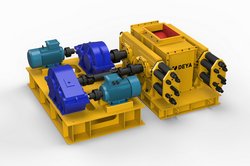Cone crusher introduction and terms
Introduction
The follow figure shows construction of a typical cone crusher.

Cone crushers are used in secondary, tertiary and quaternary stages. They are compression crushers.
A cone crusher is similar in operation to a gyratory crusher, with less steepness in the crushing chamber and more of a parallel crushing zone.
It breaks material by squeezing it between an eccentrically gyrating main shaft, which is covered by a wear resistant mantle and the concave hopper, covered by bowl liner (concave).
Working principle
As material enters the top of the cone crusher, it becomes wedged and squeezed between the mantle and the bowl liner.
Large pieces of the material are broken and then they fall to a lower position where they are broken again.
This process continues until the pieces are small enough to fall through the narrow opening at the bottom of the crusher.
The spring or hydraulic release system of a cone crusher acts as an overload protection that allows tramp iron to pass through the crushing chamber without damaging the crusher.
For automation, Deya Machinery’s cone crushers are provided modern features such as hydraulic mechanism for setting adjustment. These automation systems constantly adjust the CSS (Closed Side Setting) with no need to shut the machine down.
Wearing parts and feeding methods
They compensate for variations in feed material and wear in wear parts. They are also used for cavity clearing, in case of the machine stops during operation under load due to electric failure, etc.
Wear parts, mantle and bowl liner are made of manganese steel alloy, typical material Mn18Cr2 or Mn22Cr2.
The performance of wear parts depends on the feed arrangement, speed, stroke and closed side setting (CSS) of the crusher.
Trickle feed results in irregular liner wear. As shown in the following figure, choke feeding is the correct method for uniform liner wear. The condition in which the feed rate exceeds the product rate is known as choke feeding.
As shown in above figure, in a choke fed cone crusher, feed material is always filled above the mantle nut.
Crushing Chamber Designs
As shown in the following figure, for different materials and outputs demand, different designs of crushing chambers are available. For best performance, select the right chamber design.
Please consult Deya Machinery team if you have trouble for the selection.
Designed for Ease of Maintenance
Time spent on changing parts during maintenance, and the number of people it takes, also affect profitability.
Deya Machinery’s cone crushers are often designed for easy fitting and maintenance for example, mechanical rotation of the bowl for its removal, saving time and costs. Use of a mantle lifting device can save time and increase safety.
Cone Crusher Performance
The following factors will detract from crusher capacity and performance.
• Sticky material in crusher feed.
• Excessive moisture in the feed.
• Fines in cone crusher feed (smaller than crusher setting) exceeding 10% of crusher capacity.
• A lot of single size product in the feed.
• Feed segregation in crusher cavity.
• Improper feed distribution around circumference of crusher cavity.
• Operation of crusher at less than recommended full load countershaft (pinion shaft) speed.

Cone Crusher Terms
Mantle
Covers the cone head of the crusher to protect it from wear. It is the inner sacrificial wear liner that sits on the cone head.
Sits in the upper frame of the crusher to protect it from wear. It is the outer sacrificial wear liner that sits inside the upper frame.

Backing Compound
A resin that is poured behind the manganese liners to fill the void and secure the manganese liners.
Open Side Setting (OSS)
The maximum distance between concave and mantle at a given close side setting.
Close Side Setting (CSS)
The minimum distance between concave and mantle to give the required output and grading for a crusher.
Mantle Nut
Used on the top of the mantle to secure the mantle in place on the cone head.
Related contents
How to clear the crushing cavity of the HP cone crusher
Comprehensive guidelines for a new installed HP cone crusher initial operation





